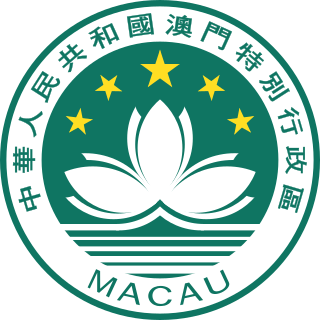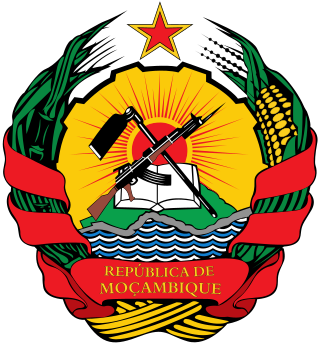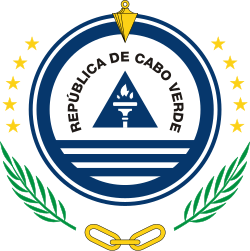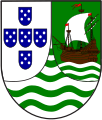
The recorded history of Cape Verde begins with the Portuguese discovery of the island in 1458. Possible early references to Cape Verde date back at least 2,000 years.

The national flag of Cape Verde was adopted on 22 September 1992, replacing the flag adopted during Cape Verdean independence, fought for with Guinea-Bissau, another former Portuguese colony on mainland West Africa.
"Cântico da Liberdade" is the national anthem of Cape Verde. It was made official in 1996, replacing "Esta É a Nossa Pátria Bem Amada", which was also the national anthem of Guinea Bissau, a legacy of both countries' joint independence. The music was composed by Adalberto Higino Tavares Silva (1961–), and the lyrics were written by Amílcar Spencer Lopes (1948–).

The national emblem of Guinea-Bissau was adopted shortly after independence from Portugal in 1973.

The national emblem of Angola is the national emblem of Angola that reflects the recent past of the new nation. There is heavy Marxist imagery found on the device, expanded from what is found on the national flag.

The flag of Equatorial Guinea was adopted on August 21, 1979. The six stars on the flag represent Equatorial Guinea's mainland and five islands. Under the rule of dictator Francisco Nguema the flag was modified and a different national emblem was used in it. After he was deposed the original flag was restored.

The current coat of arms of Zimbabwe was adopted on 21 September 1981, one year and five months after the national flag was adopted. Previously the coat of arms of Zimbabwe was identical to the former coat of arms of Rhodesia.

The emblems of the constituent republics of the Union of Soviet Socialist Republics all featured predominantly the hammer and sickle and the red star that symbolized communism, as well as a rising sun, surrounded by a wreath of wheat. The USSR State motto, Workers of the world, unite!, in both the republic's language and Russian was also placed on each one of them. In addition to those repetitive motifs, emblems of many Soviet republics also included features that were characteristic of their local landscapes, economies or cultures.

The coat of arms of Portugal is the main heraldic insignia of Portugal. The present model was officially adopted on 30 June 1911, along with the present model of the Flag of Portugal. It is based on the coat of arms used by the Kingdom of Portugal since the Middle Ages. The coat of arms of Portugal is popularly referred as the Quinas.

The Regional Emblem of the Macao Special Administrative Region of the People's Republic of China came into use on 20 December 1999, when the sovereignty of Macau was handed over from the Portuguese Republic to the People's Republic of China. The emblem is now referred to officially as the "Regional Emblem" (區徽).

The national emblem of East Timor is one of the national symbols of East Timor.

The national emblem of Mozambique was adopted in 1990 in the Constitution of Mozambique article 194. The article clearly states the design and meaning of the device. It shows a gear wheel, bordered by corn stalks and sugarcane. In the middle there is a red sun over a map of Mozambique in green, and blue waves, an AK-47 crossed with a hoe, and a book. The wreath is tied with a ribbon bearing the name of the country. The emblem is rendered in a socialist heraldry style similar to those used by the republics of the Soviet Union.

Socialist-style emblems usually follow a unique style consisting of communist symbolism. Although commonly referred to as coats of arms, most are not actually traditional heraldic achievements. Many communist governments purposely diverged from heraldic tradition in order to distance themselves from the monarchies that they usually replaced, with coats of arms being seen as symbols of the monarchs.
The Black Star of Africa is a black five-pointed star symbolizing Africa in general and Ghana in particular. The Black Star Line, founded in 1919 by Marcus Garvey as part of the Back-to-Africa movement, modelled its name on that of the White Star Line, changing the colour from white to black to symbolise ownership by black people rather than white people. The black star became a symbol of Pan-Africanism and anti-colonialism. Described as the "Lodestar of African Freedom", the black star was used in 1957 by Theodosia Okoh in the design of the Flag of Ghana.

The coats of arms of the Portuguese Empire's colonies were all of a uniform style following 1935. Two of them had, however, been using provisional coats of arms of the same style shortly prior to this.

A national emblem is an emblem or seal that is reserved for use by a nation state or multi-national state as a symbol of that nation. Many nations have a seal or emblem in addition to a national flag.

Cape Verde–Guinea Bissau relations refers to the bilateral relationship between the Republic of Cape Verde and the Republic of Guinea-Bissau. Cape Verde is an island country about 900 km north-west of Guinea-Bissau, a coastal West African country. Both were colonies of the Portuguese Empire and they campaigned together for independence with a plan for unification, but the countries separated after 1980. The two countries were both founder members of the Community of Portuguese Language Countries (CPLP) in 1996, and are each members of the African Union and the Economic Community of West African States (ECOWAS).

Bissau-Guinean nationality law is regulated by the Constitution of Guinea-Bissau, as amended; the Bissau-Guinean Nationality Regulation, and its revisions; and various international agreements to which the country is a signatory. These laws determine who is, or is eligible to be, a national of Guinea-Bissau. The legal means to acquire nationality, formal legal membership in a nation, differ from the domestic relationship of rights and obligations between a national and the nation, known as citizenship. Nationality describes the relationship of an individual to the state under international law, whereas citizenship is the domestic relationship of an individual within the nation. Bissau-Guinean nationality is typically obtained under the principle of jus soli, i.e. by birth in Guinea-Bissau, or jus sanguinis, i.e. by birth in Guinea-Bissau or abroad to parents with Bissau-Guinean nationality. It can be granted to persons with an affiliation to the country, or to a permanent resident who has lived in the country for a given period of time through naturalization.






















